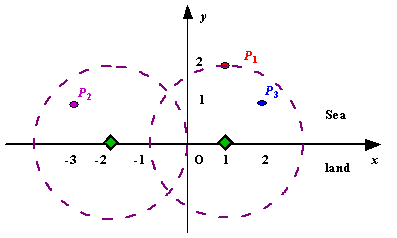【贪心】Radar Installation(POJ1328)
Description
Assume the coasting is an infinite straight line. Land is in one side of coasting, sea in the other. Each small island is a point locating in the sea side. And any radar installation, locating on the coasting, can only cover d distance, so an island in the sea can be covered by a radius installation, if the distance between them is at most d.
We use Cartesian coordinate system, defining the coasting is the x-axis. The sea side is above x-axis, and the land side below. Given the position of each island in the sea, and given the distance of the coverage of the radar installation, your task is to write a program to find the minimal number of radar installations to cover all the islands. Note that the position of an island is represented by its x-y coordinates.

Figure A Sample Input of Radar Installations
We use Cartesian coordinate system, defining the coasting is the x-axis. The sea side is above x-axis, and the land side below. Given the position of each island in the sea, and given the distance of the coverage of the radar installation, your task is to write a program to find the minimal number of radar installations to cover all the islands. Note that the position of an island is represented by its x-y coordinates.

Figure A Sample Input of Radar Installations
Input
The
input consists of several test cases. The first line of each case
contains two integers n (1<=n<=1000) and d, where n is the number
of islands in the sea and d is the distance of coverage of the radar
installation. This is followed by n lines each containing two integers
representing the coordinate of the position of each island. Then a blank
line follows to separate the cases.
The input is terminated by a line containing pair of zeros
The input is terminated by a line containing pair of zeros
Output
For
each test case output one line consisting of the test case number
followed by the minimal number of radar installations needed. "-1"
installation means no solution for that case.
Sample Input
3 2
1 2
-3 1
2 1
1 2
0 2
0 0
Sample Output
Case 1: 2
Case 2: 1
分析
刚开始我是对雷达分析,不能想出全部覆盖小岛的方法,所以改对小岛分析,小岛是必须被覆盖的,所以可以得到覆盖小岛的雷达的横坐标最小值和最大值,然后按横坐标最大值从小到大排序,运用贪心算法,在横坐标最小值处放雷达,雷达就可以尽可能多的覆盖小岛。还有两个特殊情况:
①小岛y坐标大于雷达覆盖半径的话,就要输出-1。
②当横坐标最大值相同时,应让半径小的排在前,因为要在横坐标最小值处放雷达,这样可以保证横坐标最大值相同时都可以覆盖到。
参考代码
//这是我写的,大多数样例都过了,但是一直WA,T.T
#include <iostream>
#include <cstdio>
#include <math.h>
#include <algorithm>
using namespace std;
struct P{
double l;
double r;
}p[1001];
bool compare(const P& a,const P& b);
int main()
{
int sum=1;
int n;
double d;
double x,y;
int maxy=0;
int num=1;
while(1){
maxy=0;
sum=1;
scanf("%d%lf",&n,&d);
if(n==0&&d==0)
break;
for(int i=0;i<n;i++){
scanf("%lf%lf",&x,&y);
if(y>maxy){
maxy=y;
}
double t=sqrt(d*d-y*y);
p[i].l=x-t;
p[i].r=x+t;
}
if(maxy>d){
printf("Case %d: -1\n",num++);
}
sort(p,p+n,compare);
int minx=p[0].r;
for(int i=1;i<n;i++){
if(minx<p[i].l){
sum++;
minx=p[i].r;
}
}
if(maxy<=d)
printf("Case %d: %d\n",num++,sum);
}
return 0;
}
bool compare(const P& a,const P& b){
if(a.r==b.r)
return a.l>b.l;
return a.r<b.r;
}
//AC代码摘自http://www.cnblogs.com/q-c-y/p/4713557.html
#include<iostream>
#include<cmath>
#include<cstdio>
#include<algorithm>
#define MAX 1005
using namespace std;
struct note{
double left,right;
}b[MAX];
double cmp(note a,note b) //结构体排序
{
if(a.right==b.right) return a.left>b.left;
else
return a.right<b.right;
}
int acount,n;
void search(double maxn) //找到最少的雷达数
{
int i;
for(i=1;i<n;i++)
if(b[i].left>maxn)
{
maxn=b[i].right; //都取最右端
acount++;
}
}
int main()
{
double d,x,y;
scanf("%d%lf",&n,&d);
int t=0;
while(n||d)
{
t++;
int o=0;
acount=0;
for(int i=0;i<n;i++)
{
scanf("%lf%lf",&x,&y);
if(y>d) //判断是否可以扫射到岛
o++;
b[i].left=x-sqrt((d*d)-(y*y)); //预处理,变成区间
b[i].right=x+sqrt((d*d)-(y*y));
}
if(!o)
{
sort(b,b+n,cmp);
search(b[0].right);
printf("Case %d: %d\n",t,acount+1);
}
else
printf("Case %d: -1\n",t);
scanf("%d%lf",&n,&d);
}
return 0;
}
祝你早日攒够失望,然后开始新的生活。



